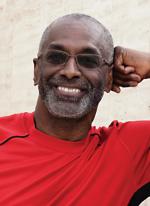The Senior Solutions Architect
Fall
2016
Spotlight on Hidden Physicists
The Senior Solutions Architect
Ron Williams, Sr. Solutions Architect at American Airlines
I solve problems.
As a solutions architect, I design IT solutions for whatever problems my colleagues think up. My job is to look at what technologies are available to solve a problem, how they can be applied, and determine the best solution.
 As an engineer you have a certain set of tools. If I give you a problem, you use those tools to solve it. As a solutions architect it’s not what you know that matters, it’s what you don’t know. Your job is to figure out what tools are available and use them to find a solution. It’s because of my skills as a physicist that I’m able to quickly understand a situation and jump into problem-solving mode.
As an engineer you have a certain set of tools. If I give you a problem, you use those tools to solve it. As a solutions architect it’s not what you know that matters, it’s what you don’t know. Your job is to figure out what tools are available and use them to find a solution. It’s because of my skills as a physicist that I’m able to quickly understand a situation and jump into problem-solving mode.
I became a physicist in 7th grade. I was interested in length contraction and started asking questions that my teacher couldn’t answer. My teacher, Mr. Allen, went out and got books for me. I discovered Einstein and was a physicist from then on.
After getting my master’s in space physics in 1984, I was supposed to go to Rice University to get a PhD. Instead, I ended up doing IT work for NASA. I supported other physicists, extracting science from the data of satellites and shuttle missions. After that I did some work for the Department of Defense on the Star Wars program (the Strategic Defense Initiative). We simulated flying missiles and used physics to blow things up and see what happened.
I worked in IT and management for several companies in the 1990s. I solved problems in budgets, technology usability, network performance, and project management. Because of this, I spent the next several years working as a consultant. This took me all over the world, from Brazil to the United Kingdom.
Of all the problems I have worked on, one of the solutions that I am most proud of came from my time as chief technical architect for Topgolf. Topgolf is a family-friendly driving range in which you hit golf balls at various targets, depending on which game you are playing. Hundreds of people can play at once, and the system has to keep track of everything in real time. I designed the hardware, software, and engineering to make this possible.
I now work for American Airlines. As a senior solutions architect, knowledge about airport planning or a particular American Airlines system is a lot less important than knowing how to solve problems. I deal with lots of different vendors and lots of different technologies to solve whatever problem needs solving. If something we need doesn’t exist yet, it’s my job to figure out what to do.
My advice to Sigma Pi Sigma members is this: Always be willing to say, “Is there another way of looking at this?” It’s important not to become rigid in your thinking and to know the limits of your knowledge. Knowing that you don’t know something means that you can make a change.
